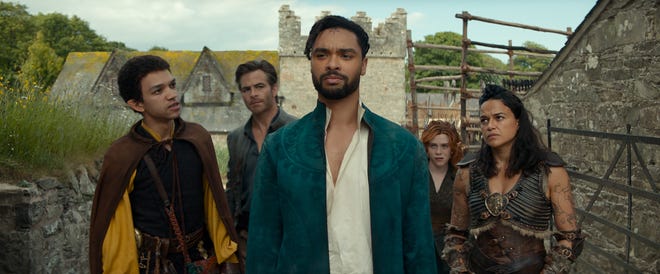[ad_1]
Break out the 20-sided dice because Dungeons & Dragons is on a roll.
Introduced in 1974, the tabletop role-playing game has been a staple for generations of fantasy fans, is enjoying a recent surge in popularity with people finding and watching D&D online, and could be in for more mainstream attention with the new adventure film “Dungeons & Dragons: Honor Among Thieves” (in theaters Friday) starring Chris Pine, Michelle Rodriguez, Regé-Jean Page and Hugh Grant.
Whether you’re curious about the game after seeing the movie or just want to find your inner warlock, here’s what you need to know about D&D:
So how you do play ‘Dungeons & Dragons,’ anyway?

Players take on a type of character in their “party” – be it a powerful barbarian, sneaky rogue, magic-wielding sorcerer, or heroic paladin – while one person is the Dungeon Master who presents monsters, obstacles and other encounters for the characters to face with the roll of a die. Any number of players can participate in a campaign, all you need to play is a rulebook, character sheet, pencil and dice, and unlike other games, there’s no winning or losing – D&D is all about improving your character and collaborating on a story with others.
Want to jump into a game or learn the basics? Start by reaching out to friends, says Shelly Mazzanoble, who co-hosts the official D&D podcast “Dragon Talk” with Greg Tito: “There’s a lot of people around you who already are playing D&D, and I guarantee you, that they will be very welcoming.” (Game stores around the country will host “learn to play” events April 7-9.)
We have ‘Dungeons & Dragons’ to thank for all sorts of nerd stuff

Here’s a fun fact: D&D was the epitome of geek culture way before “Harry Potter,” “Game of Thrones” and Marvel movies made it cool. The game has popped up in “Stranger Things” and “The Big Bang Theory,” and has deeply affected the video game industry, with many role-playing titles like “World of Warcraft” and “Elden Ring” using the D&D system of creating a character, gaining experience points and “leveling up” as one’s personal progression is coupled with story progression.
D&D historian Jon Peterson, author of books such as “Game Wizards,” compares the game to punk rock in terms of its cultural impact: “It isn’t as significant as the internet, but it’s on the same list.”
The controversy around ‘Dungeons & Dragons,’ explained

D&D has been criticized for racist depictions and stereotypes in its game materials, and a recent fifth edition of its official compendium focused on accessibility, inclusion and diversity. “That has allowed more people to see themselves in a fantasy heroic adventuring context,” Tito says.
There was also some trouble back in its early years: Those of a certain age might remember their moms being wary of the game during the Satanic panic of the ’80s when Christian and conservative groups accused D&D of promoting devil worship.
Game publishers did make changes: In the late 1980s, Peterson says they removed the terms “demon” and “devil” from the Monster Manual and a book called “Deities & Demigods” was renamed “Legends & Lore.” However, the hubbub made it all the more attractive for youngsters. “Seeing on the local news Pat Robertson saying, ‘This is so bad for you,’ of course, it quadrupled sales pretty much overnight when that started happening,” Peterson adds.
Online ‘D&D’ was a saving grace for isolated players during the pandemic

In the past decade, there’s been a rise in playing on Zoom and the social platform Discord, plus folks watching D&D campaigns via the YouTube series “Critical Role” and Twitch livestreams. During the pandemic, people gravitated toward playing D&D online “to have this creative outlet (and) escape this little insular world that we were all living in,” says Mazzanoble, who co-wrote the book “Welcome to Dragon Talk” with Tito.
Before 2019, Tito says, 80% of fans were playing D&D in person vs. 20% online – the next year, the percentages flipped. Even now, more people are online than not. “I can play with someone in Japan (or) in Australia,” he says. “As long as we’re all agreeing on a time, the location doesn’t matter, we can all play together.”
‘Honor Among Thieves’ filmmakers bring the game to the big screen

John Francis Daley, who directed the new “Dragons” movie with Jonathan Goldstein, bowed out of a D&D campaign that had been going for three and a half years to focus on filming. It was important to him that “Honor Among Thieves” reflects the joy of being part of a game as opposed to more somber or serious fantasy fare. “The idea of injecting that sense of fun and humor that you get out of playing is not a betrayal of the genre,” Daley says. “In fact, it’s embracing what makes D&D so special.”
Naturally, some legendary monsters are in the movie, too, like the deadly gelatinous cube and feline displacer beast. Goldstein says the ones they picked came from a “somewhat complicated calculus” of what they could depict realistically, fans’ favorites and what served the story best. “And we also needed to have a couple of dragons in there, for obvious reasons.”
For many, ‘Dungeons and Dragons’ levels up their lives
One major appeal for Daley: “It’s such a really interesting way to communicate and socialize with your friends that in many ways feels more organic than having a surface-level conversation.”
And Mazzanoble is glad to see the game inspiring children as it has since the ’70s. “I’ll never tell the kids this, but yes, you’re going to get pretty good at reading, you’re going to get probably inspired to do a lot of writing and you’re going to do a lot of math,” she says. “But they’re also learning leadership, empathy, inclusion, collaboration, team building, and simple things like wait your turn.”
For more on ‘Dungeons’ and its stars:
[ad_2]
Source link






